Sprouting potato tubers before planting: how long, which method is better - in the dark or in the light
After sorting and selecting the most suitable tubers, the following mandatory procedure is performed preparing potatoes for planting - germination of its tubers.
Next, let's talk about the timing, methods and features of germinating potato tubers before planting them in the ground. Let's analyze the main differences, advantages and disadvantages of germination in the light and in the dark.
By the way! Sprouting potatoes is also sometimes called warming up (after all, for germination, in any case, you must transfer the tubers to a warmer place), in other words, many use these concepts as synonyms.
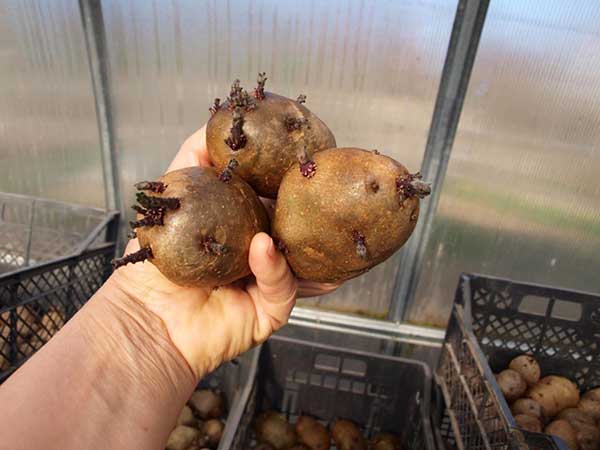
Content
Why sprout potatoes before planting
Sprouting potato tubers before spring planting is carried out to achieve the following goals:
- Tuber awakening after a winter match.
- Disease detection (more on this later).
- Promotions resistance of potatoes to diseases and pests.
- Receiving more early harvest.
- Receipt high harvest.
However, the achievement of certain goals depends on the method of germination and often mutually exclude some of them.
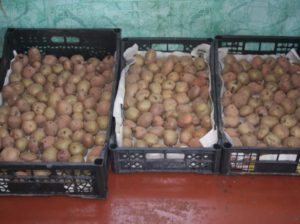
When to lay potato tubers for germination
You need to start sprouting potatoes about a month before landing, even desirable in 6-7 weeks (i.e. for 1.5 months).
Advice! The site contains material about when you can and should plant potatoes.
This time will be enough for the potato to fully awaken after hibernation, warm up and grow short strong shoots. However, the timing of germination may differ (the higher the temperature, the faster it will grow), so it is necessary to act according to the situation.
Important! Tubers, on which sprouts have not formed during this time, does not make sense to plant.
What to do if tubers started sprouting in the basement ahead of time
If you had to remove the tubers too early, i.e. they began to sprout in the storage place (in the basement, cellar) due to the increase in temperature (the optimal temperature regime for storing potatoes is + 2..4 degrees), then in this case, potatoes need reach the light fasterso that the shoots stop growing in length.
Unfortunately, often in the light, very long shoots begin to bend (fall), turn black and eventually die (dry out). This is a completely normal process of drying out the sprouts. However, do not rush to discard such tubers: after the old shoots have fallen off, new ones will most likely begin to appear and grow.
Until what point (how long the shoots) to germinate tubers
As for the optimal size and length of sprouts, there is no consensus here, however, most experts and summer residents prefer to plant potatoes with 1-1.5 (maximum 2) centimeter outgrowths, others - from 3-4 cm. Try this and that.
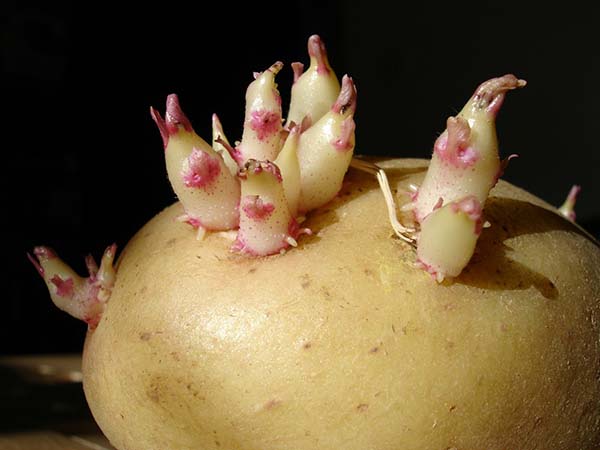
- Why is it not recommended to plant potatoes with longer sprouts?
Everything is simple and logical: when landing, you can it is very easy to break them off, and then the development of the potatoes will be delayed (and, most likely, the yield will drop).
Opinion: “Planting with long white seedlings is difficult because they are very delicate and break off easily. Even if it was possible to bring these seedlings to the hole and spread out, then when falling asleep, and especially after the soil begins to sit down and compact, they still break off. Therefore, I plant them with short green shoots, spreading them in the holes with seedlings up.
However, if planted carefully, then the harvest can please you.
The main thing that the sprouts were quite thick and vigorous (strong).
And here with thin, uncharacteristic sprouts, should not be planted... This is considered a "sprout" symptom and is caused by viruses.
Note! The temperature of the ground in which you are going to plant the tubers should be equal to the temperature of the potatoes, or higher - only then will the potatoes start growing.
Potato germination methods: their features and benefits
Next, we will take a closer look at all the main methods and nuances of sprouting potatoes before planting.
There is a huge amount of controversy and opposing opinions on the Internet regarding how to germinate potatoes - in the light or in the dark. Let's try and we will approach this situation from different angles.
In the light
For germination in the light, the tubers are laid out in boxes in 1 layer, wherein germ (eyes) must be turned towards the light.
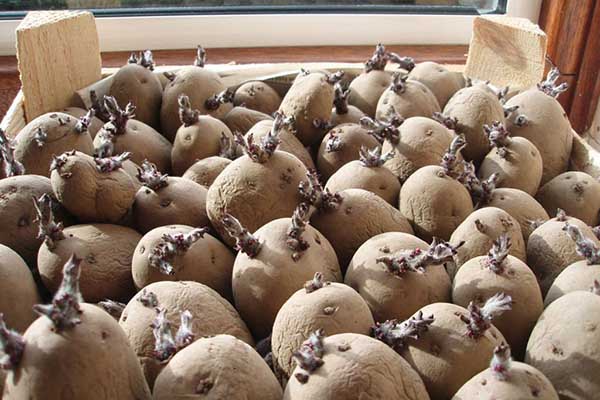
The tubers should get diffused lightrather than direct sunlight.
Vernalization processes will run as well in potatoes if daytime temperature will be supported in the area +12 .. + 15 degrees, and at night the thermometer will drop at least + 6-8 degrees.
Where can you find such a bright (but not sunny) and cool place?
A north, north-east window will do, or you can additionally switch it to winter ventilation mode. Alternatively, arrange the tubers on a glazed balcony (north or north-east).
When germinating in the light, short but strong greens (can be purple, blue and even yellow) sprouts.
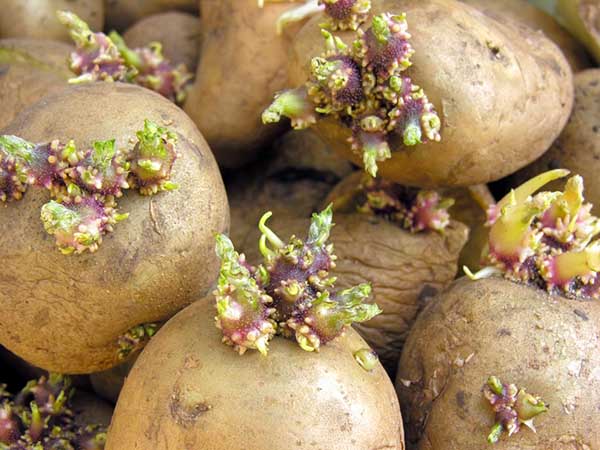
Arguments for sprouting potatoes in the light:
- Solanine is produced in potatoes in the light. Solanin has fungicidal and insecticidal properties, playing the role of natural plant protection. And although its protection is not enough to resist the Colorado beetle (it is not susceptible), still solanine can inhibit the development of diseases and damage to the tuber nematode and wireworm.
Solanine production is characterized by greening tubers.
- In the light, sprouts will grow stronger and not elongated (as when germinating in the dark), which means that in the future, more stolons = higher yield.
- There is a controversial opinion that with light germination, diseased sprouts can also clearly appear, respectively, you can also determine that such a tuber is better to be discarded.
In the dark
If you decide to germinate in the dark, then room temperature should be within +8 .. + 12 degrees.
When germinating in the dark, long (often thin and elongated threadlike) white sprouts.
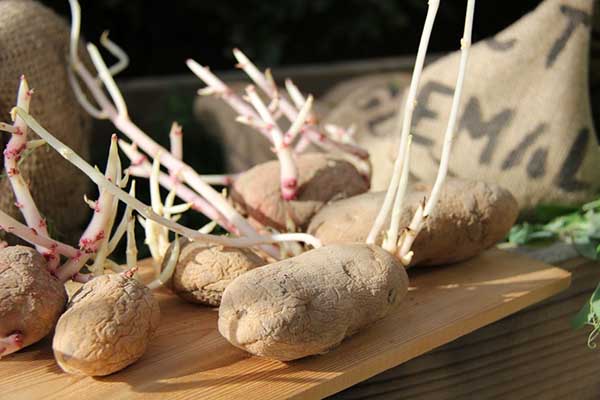
Important! When planting, the growth points must be placed above the soil surface.
Arguments for sprouting potatoes in the dark:
- When germinating in the dark, you can provoke some potato diseases that will become clearly visible on the tubers (for example, black tips). Naturally, it will be necessary to get rid of such tubers, i.e. carry out additional sorting (culling of painful potatoes).
- Potatoes sprouted in the dark rises much earlier (after 10-12 days), in the light - much later (after 18-20 days).
Accordingly, if you want to get an earlier crop of potatoes, then germinate in the dark.
- Germination in the dark more naturalsince tubers for most of their life are either in the ground or in the basement (without access to light).
On the other hand, when germinating in the light, the tubers end up producing a lot of chlorophyll (solanine).
- Potatoes sprouted in the dark will give a much higher yield, because stolons are future tubers that are better laid on long white shoots.
- There is also an opinion that germination in the dark contributes to the "waking up" of a larger number of eyes.
With high humidity in the dark
It is possible to germinate potatoes in a shorter time (i.e. faster - in 3-4 weeks) in the dark and at high air humidity (about 80-90%). To do this, the tubers should be placed in any easily moisturized substrate. For example, it can be the same humus, peat, moss, or even better sawdust, or any other loose material. Moreover, the top and bottom should be at least 2-4 centimeters of the substrate. Maintaining moisture is carried out by regularly spraying the substrate in which the tubers are located until good sprouts appear.
With this method of germination, not only sprouts, but also roots are formed on the tubers, moreover, much faster.
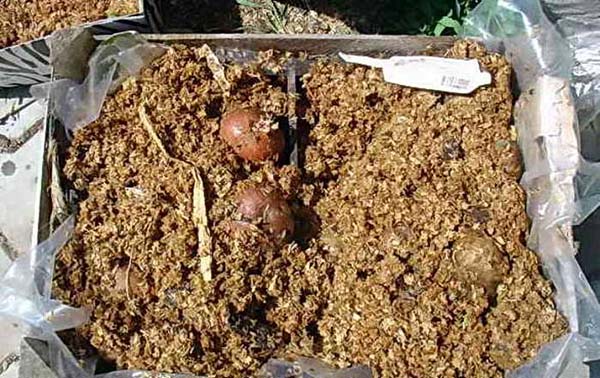
Advice! You can increase the efficiency of germination in a humid environment if, instead of water, you spray, one might even say, treat the potato tubers with a solution of copper sulfate (but very weak, somewhere between 1-2 grams of agent per 10 liters of water), one of the growth stimulants (for example , Epin or Zircon).
Video: sprouting potatoes in the dark - features and benefits
Which method of germination is the highest yield - in the light or in the dark
Obviously, tubers form in the dark.Accordingly, stolons will grow in the dark. However, there are 2 opposite opinions about the moment of their formation:
- So, the first consider: “Stolons are formed much later - like underground shoots from that strong light sprout that forms on a tuber in the light. At the time of tuber germination, there are no stolons on it yet. Sprouts are future stems, at the base of which roots may already have formed at the time of planting, especially if germination proceeded in the dark and in humid conditions. And it would be nice if these stems were strong and thick, and not elongated and frail. The thicker and more compact the stem, the more stolons will be formed on it in the future, the higher the yield will be ”.
- Second opinion the following: “A tuber sprouted in the light, i.e. having a green sprout, does not lay stolons, on which tubers then appear, since it only grows, so to speak, "strives for the light", and only for the seed. The fact is that the greening of tubers, even if they are accidentally exposed to light, is also a defensive reaction. Stolons and then tubers are laid only on white sprouts. "
Video: comparison of methods for germinating potatoes in the light and in the dark
Note! The author is of the exclusive opinion that it is necessary to germinate only in the dark and nothing else.
Compromise way - first in the dark, then in the light
However, the most compromise and effective solution would be to use the following technology for sprouting potato tubers (which is used in Germany and the Netherlands, where, so to speak, "they know how to grow potatoes"):
- So, first 2-3 weeks tubers should be germinated in the dark at a temperature of +10 .. + 12 degrees, until the length of the shoots reaches 1-1.5 cm. If the shoots are growing too quickly, then in order to stop their growth, you need to reduce the temperature, i.e. transfer the potatoes to a cooler place (not lower than +5 degrees).
- By keeping the tubers in the dark, they will be able to grow sprouts. In other words, in the dark, you will stimulate the germination of their eyes (the appearance of sprouts).
- Also, when germinating in the dark, you can discard painful tubers. As a rule, the tips of the sprouts turn black and their growth stops. And further in the light, only healthy specimens need to be germinated!
- And then transfer tubers to light (into a bright room) and continue to germinate them (which will take about 4-6 weeks) at a higher temperature +12 .. + 15 degrees (Tip: in the first 2-3 days, you can do a heatstroke - keep at a temperature of 18-20 degrees) to get strong shoots (green or purple), which will be more resistant to diseases and pests at an early stage of their development.
In the light, the sprouts will become thick and strong, while remaining relatively short.
- Why is it not recommended to germinate immediately in the light?
If you place still dormant tubers (with dormant eyes) directly into the light, then it blocks growth in length. Therefore, first we germinate in the dark, i.e. We drive out the sprout, and only then we place it in the light so that the sprout becomes thick and strong.
Fast germination (warming up)
An easier and faster way to germinate is to warm up the potatoes before planting.
Tubers for warming up should be taken out much later, about 1-2 weeks before the date of the proposed planting.
All you need to do is just keep the tubers during this time in a warm room, where the average temperature is + 20-22 degrees.
Note! Do not overexpose the tubers in such conditions, otherwise you can get overly elongated and thin sprouts, which will simply break off when planted.
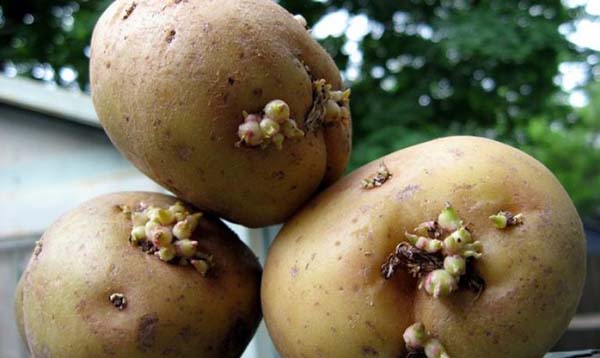
Some experienced gardeners like to use, in a sense, "shock" heating of tubers, keeping them for 2-3 hours at a temperature of about + 30-40 degrees, then leaving them to warm up in a room where the thermometer is in the range of + 18-22 degrees.The next day, they are already planted in open ground.
Brief answers to popular questions about sprouting potatoes
When to plant tubers for germination?
A month and a half before planting, depending on the method of germination and the required length of shoots.
Is it possible to germinate tubers in special solutions for their processing?
No, this procedure is not recommended. The fact is that tubers can be kept in such solutions for no more than a day (and preferably about 5-10 minutes, maximum 20-30 minutes), and germination takes a much longer time.
What is the best way to germinate potato tubers - in the light or in the dark?
Everyone comes to the answer to this question independently (the arguments of each method are described in separate paragraphs).
If the tubers are healthy, then in fact there is not much difference - to germinate in the light or in the dark. Light germination does not relieve the tuber of all, of course, but of some diseases and pests. However, it is in the dark that diseases manifest better, and diseased tubers can be discarded immediately.
Is there a compromise?
Yes, this is the initial germination in the dark and the subsequent germination in the light (described in detail in the corresponding paragraph).
Which method of germination is the best yield?
There is no statistically reliable information, but, on resistance to diseases, there are: germinated in the light much better resistance to diseases and pests.
The tips of the sprouts turned black during germination, what should I do?
If sprouts started turn black, then this may be a manifestation of any disease or the presence of a virus. Often potatoes with black sprouts eventually get sick late blight.
By the way! Be sure to rinse the nodules well before germination. Sometimes, even at this stage, you can also detect an infection rhizoctonia (also called "Black scab") - it looks like adhered dirt that cannot be cleaned off. You cannot plant such potatoes!
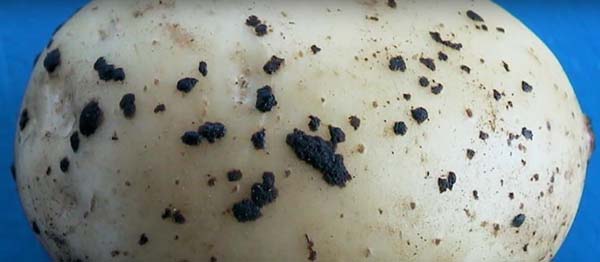
Thus, there is a fairly widespread opinion that the formation of black shoots (their blackening during germination) is a sure indicator that the tuber is 100% infected with some kind of disease (an infection, possibly a viral one).
However, it is not at all necessary that it is a disease. A dense cork layer can form in the black sprout (its tip), which helps the sprout to break through the soil. For example, it can be such a specific varietal trait.
By the way! Discarded potatoes (with blackened sprout tips) are quite can be used for food.
In any case, you need to look at the general condition of the tuber and sprout. A healthy tuber has vigorous sprouts.
Is it possible to break off overgrown sprouts?
In no case should the sprouts be broken off: each such breaking off will reduce the yield of tubers.
So what do you do?
Promptly bring tubers with overgrown sprouts to light in order to slow down their growth, or to a cooler room (lower the temperature of the content).
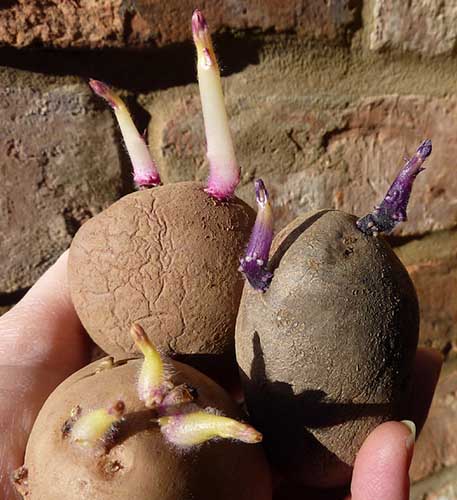
Well, you received all the information on sprouting potatoes, now it's up to you! Try it, experiment! Find your way!
Advice! After germination, do not forget to potato processingby pickling in one of the fungicidal and / or insecticidal solutions.

